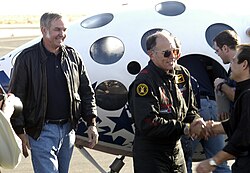Mike Melvill | |
|---|---|
 Melvill in 2004 | |
| Born | Michael Winston Melvill November 30, 1940 |
| Nationality | South African / American [1] |
| Alma mater | Hilton College |
| Occupation | Test pilot |
| Space career | |
| Commercial astronaut | |
Time in space | 7 mins (roughly estimated) |
| Selection | SpaceShipOne 2003 |
| Missions | SpaceShipOne flight 15P, SpaceShipOne flight 16P |
Michael Winston Melvill (born November 30, 1940, in Johannesburg, South Africa) [1] is a world-record-breaking pilot [2] and one of the test pilots for SpaceShipOne, the experimental spaceplane developed by Scaled Composites. Melvill piloted SpaceShipOne on its first flight past the edge of space, flight 15P on June 21, 2004, [3] thus becoming the first commercial astronaut, and the 435th person to go into space. [4] He was also the pilot on SpaceShipOne's flight 16P, the first competitive flight in the Ansari X Prize competition. [5]



